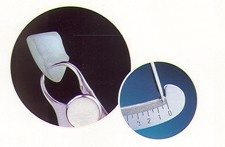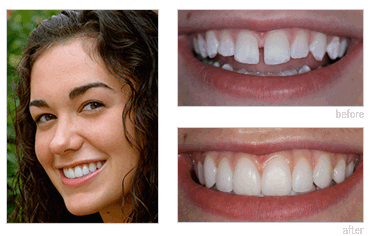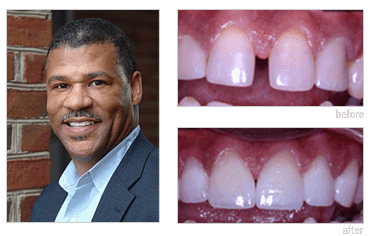There are several brands of porcelain veneers available to cosmetic dentists that are strong enough to be ultra-thin.
Conventional porcelain veneers are made to be 0.5 mm thick, minimum. This is about the thickness of a fingernail, and I believe it is an adequate thinness for most situations. But there is a place for a thinner porcelain. At the usual thinness of ultra-thin porcelains, 0.3 mm, it would be possible to do a smile makeover with very little or no tooth reduction.
Lumineers are the most heavily marketed brand of ultra-thin porcelain. I am quite critical of Lumineers on this website, as I have seen much mediocre cosmetic dentistry done with Lumineers, some that has even been featured on their company website. Click the link to read what I say about Lumineers and to see the before-and-after photos I’m talking about.

DURAthin veneers can be
made 0.3mm thick.
I’m Not As Critical of DURAthin Veneers
I don’t feel as inclined to be as critical of other brands of ultra-thin veneers, including DURAthin. They are similar to Lumineer porcelain, in that they can also be made ultra-thin. But these other porcelains look to me to be more esthetic material. And I have seen photographs of truly beautiful ultra-thin veneers, made with DURAthin or other brands. However, I have never seen a smile with Lumineers that I would call truly beautiful.
There are two basic problems with Lumineers that are overcome with DURAthin and other similar brands of ultra-thin porcelain. The first and most important problem is in the trademark restrictions placed by the company that makes Lumineers. These restrictions state that the manufacturer will only allow them to be made at the DenMat Laboratory. This laboratory has been criticized by expert cosmetic dentists as producing mediocre esthetic results. On the other hand, these other brands can be used by any dental ceramist, many of whom are highly artistic. For that reason, expert cosmetic dentists will generally stay away from Lumineers.
The second reason is in the esthetic quality of the porcelain. Lumineers are a little pasty and opaque-looking. DURAthin has a more natural translucency to it. Though some marketing materials put out by DenMat recently suggest that they may be trying to address that problem.
I also think part of the difference may be in the dentists they attract. The marketing of Lumineers to professionals is framed as being so easy to place and so lucrative. And then they put the stamp of “certified” on the dentist to lend credibility to the dentist’s own marketing campaign, a credibility which I feel would be more appropriately earned with several years of continuing education and experience rather than a single two-day course. From e-mails that I have received and websites and photographs I have examined, this seems to attract a dentist whose commitment to cosmetic dentistry seems too often to be superficial.
On the other hand, the dentists that I have seen who use DURAthin veneers or other competing brands of porcelain are a much higher caliber. They include a number of the dentists we recommend on this website, and I have yet to see a photograph of a DURAthin case that I think looks mediocre. I’m sure such cases exist, but the several I have seen all look very nice. I have posted a couple below.
DURAthin Pictures
Click here to ask Dr. Hall a question.
This content was written by Dr. David Hall.


